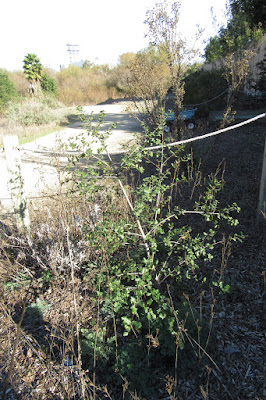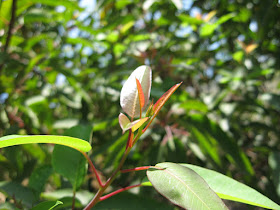 |
| California scrub oak (Quercus berberidifolia): Mother Nature's Garden of Health, Gardena, California |
Limited
gardening space requires thoughtful plant choices. Good plants for smaller gardens combine
beauty, usefulness and habitat value; what we like to think of as ‘value added’
plants. Some of the best evergreen habitat plants are the native live oaks.
They are also attractive and provide food (for those willing to process the
acorns). And fortunately, several local live oaks are small enough to be considered
for suburban gardens. One of our
favorites is Quercus berberidifolia. The scientific name is pronounced: KWER-kus
ber-ber-id-i-FO-lee-uh.
California
is blessed with twenty-one species of native oaks. Of these, sixteen are native to Los Angeles
County – a remarkable amount of oak biodiversity. The Southern California oaks are mostly
evergreen (thirteen of sixteen species).
And of the evergreens, only five (Quercus
agrifolia; Q. chrysolepis; Q. engelmannii; Q. tomentella; Q. wislizeni) are
large trees. The rest are large shrubs or small trees,
of a size suitable for smaller landscapes.
 |
| California scrub oak (Quercus berberidifolia) vs. Nattall's scrub oak Quercus dumosa) |
Among the smaller S. California live oaks, Quercus berberidifolia and Quercus dumosa (Nuttall’s scrub oak) are most widely available in the nursery trade. Like most oaks, the scrub oaks of California are prone to hybridization, producing a number of hybrid forms. It’s likely that some plants available for purchase are actually hybrids. And there’s still considerable debate about the range and characteristic morphology of these two species. The interested reader is directed to references 1-6, below, for more on this evolving topic.
Quercus berberidifolia is known by several common names: Inland
Scrub Oak; California scrub oak; Scrub oak.
It belongs to the Family Fagaceae
(the Beech Family) and is a member of the White Oak section of the genus Quercus. Its range extends from the
Northern California coastal foothills to Baja California, Mexico. In Los
Angeles County, it can be found in the Santa Monica and Verdugo Mountains and
the foothills of the San Gabriel Range, below about 5000 ft. elevation. It is most commonly associated with the
chaparral plant community.
 |
| California scrub oak (Quercus berberidifolia): 3 years in ground |
 |
| California scrub oak (Quercus berberidifolia): 4 years in ground |
The
California scrub oak is a small, evergreen or semi-evergreen shrubby oak. When young, it has a somewhat scraggly
appearance (above). With age, it develops its characteristic mounded form. It typically grows no taller than about 9-10
ft. (to 3 meters), but may grow 15+ ft. in prime locations. It often is slightly wider than tall: usually
15-20+ ft. wide. It has light green-gray
to gray, smooth bark. The foliage is
dense, making this a good screening shrub.
The reader is directed to references 7-9, below, for more photos.
Quercus berberidifolia is a slow growing plant, adding 1-2
ft. of new growth each year. It’s also
long-lived in the wilds – likely several hundred years. It’s often difficult to tell the precise age
of oaks that grow in fire-prone areas.
Like many local oaks, Quercus
berberidifolia re-sprouts after a fire. So the age of individual stems may
be significantly less than the actual age of the plant. For more on the fire-relations of this
species, see reference 10.
 |
| California scrub oak (Quercus berberidifolia): foliage |
Quercus berberidifolia has small, often holly-like leaves –
hence the scientific name. The leaves
are thick, stiff and shiny to dull above.
The undersides of the leaves have sparse hairs (trichomes). The shape of leaves can vary tremendously,
even on a single plant (see references 9 and 11 for examples).
Like
all oaks, Quercus berberidifolia is
wind pollinated. The separate male and
female flowers occur on the same tree.
Plants bloom in winter or early spring – usually February or March at
lower elevations. The male flowers, with
their yellow pollen, grow on dangling, one-inch catkins. The pollen is not
usually a problem for human allergy sufferers. The female flowers are often
hidden by leaves. The acorns, which
develop from the female flowers, are broad and chunky. They look distinctively different from the
longer, tapered acorns of the Coast live oak (Quercus agrifolia) and Quercus
dumosa. Acorns ripen 6-8 months after pollination. New seedlings can be started quite easily from
fresh acorns in the fall.
 |
| California scrub oak (Quercus berberidifolia): sunny site |
California scrub oak likes a site with full sun to part-shade. It grows in most well-drained local soils except those with high salinity (no recycled water). It can succeed in clays and clay-loams, as long as summer water is kept to a minimum. In soils with reasonable drainage, it can be deeply watered every 4-6 weeks during the dry season. The first 4-5 years, when plants are establishing, they require monthly water in most locales. Then plants are quite drought tolerant. This species has deep roots that require a few years to develop.
It’s
best to let oak trees self-mulch, and Quercus
berberidifolia is no exception. Oak leaves help with soil moisture
retention. They also contain plant
chemicals that likely provide protection from pests and diseases. The leaves
also repel slugs, snails and grubs. So,
leave the leaves in place when they fall.
California
scrub oak is generally easy to grow. It is
susceptible to several oak pests, including several types of borers, and to
soil and other fungal diseases. For an
excellent guide to the pests and diseases of California oaks see reference 12.
 |
| Scrub jays and others love acorns! |
The California scrub oak is an excellent habitat plant. The dense foliage provides cover and nesting sites for birds. The shade and cover are utilized by smaller, ground dwelling animals from rabbits to lizards and doves. The acorns are a favorite food of Jays, woodpeckers, squirrels and other animals. In the wilds, young foliage is sometimes browsed by larger animals (deer, sheep, bears).
Oaks
in general provide important habitat for a wide range of beneficial insects. These,
in turn, attract the insect-eating birds.
Butterflies for which this oak provides larval food include the
California Sister, Propertius Duskywing, Mournful Duskywing, Golden Hairstreak,
and Gold-Hunter's Hairstreak.
 |
| California scrub oak (Quercus berberidifolia): habitat for Duskywing butterflies |
The
acorns of Quercus berberidifolia are
edible, though not as tasty as those of other native oaks, particularly the
Black oaks. Acorns must be leached of
their bitter tannins – an involved process – before being useful as acorn
meal. The galls that grow on oak trees
are strongly astringent and were traditionally used in the treatment of bleeding
and chronic diarrhea.
 |
| California scrub oak (Quercus berberidifolia) |
In summary, native scrub oaks can be useful evergreen shrubs or small trees in suburban landscapes. They can be used as background shrubs, for large hedges/hedgerows or pruned up as small shade trees. They grow well on slopes, with a minimum of care once established. They can be planted in dry parking strips and can even be used as bonsai or container plants. They can be shaped or left to develop their own natural form. They are resilient and water-wise.
Oaks
also have much to recommend them as representatives of our California heritage.
They bring many types of wildlife to the garden and even provide a source of
human food. They recall a time when oaks were key to human survival. They are among our most important native
plants and their habitat is disappearing in some areas. That’s why Los Angeles County oaks are
protected by The Los Angeles County Oak Tree Ordinance. And these are just a few reasons to plant Quercus berberidifolia in your own
garden.
 |
| California scrub oak (Quercus berberidifolia): part of mixed hedgerow, Mother Nature's Garden of Health |
For a
gardening information sheet see: https://www.slideshare.net/cvadheim/gardening-sheet-quercus-berberidifolia-126900433
For plant
information sheets on other native plants see: http://nativeplantscsudh.blogspot.com/p/gallery-of-native-plants_17.html
____________________
- http://tchester.org/plants/analysis/quercus/scrub_oaks.html
- https://www.researchgate.net/figure/Distribution-of-nine-White-Oak-species-in-California-a-Quercus-berberidifolia-b_fig1_308632217
- https://www2.palomar.edu/users/warmstrong/hybrids2.htm
- http://sandiego.sierraclub.org/rareplants/203.html
- http://danr.ucop.edu/ihrmp/proceed/nixon.pdf
- http://www.biosbcc.net/b100plant/htm/qberberidifolia.htm
- http://plantid.net/Gallery.aspx?Taxon=Quercus%20berberidifolia
- https://calphotos.berkeley.edu/cgi/img_query?where-genre=Plant&where-taxon=Quercus+berberidifolia
- http://nathistoc.bio.uci.edu/plants/Fagaceae/Quercus%20berberidifolia.htm
- https://www.fs.fed.us/database/feis/plants/shrub/quespp2/all.html
- https://www.smmflowers.org/mobile/species/Quercus_berberidifolia.htm
- http://www.suddenoakdeath.org/pdf/psw_gtr197.pdf
We welcome your comments (below). You can also send your questions to: mothernaturesbackyard10@gmail.com























